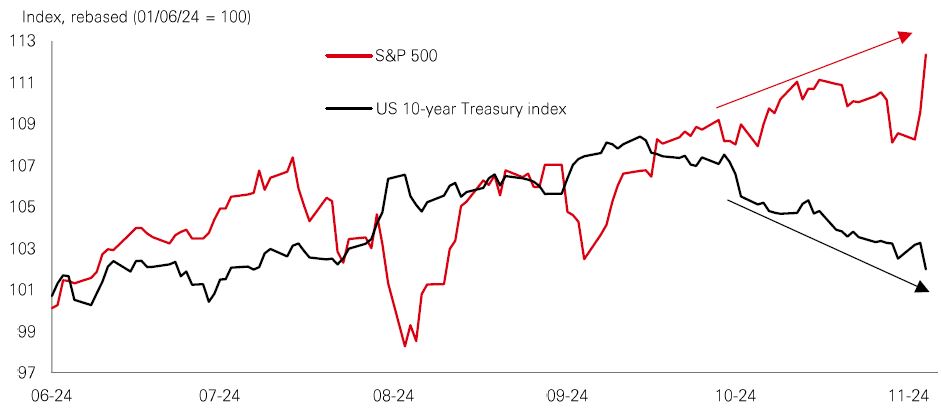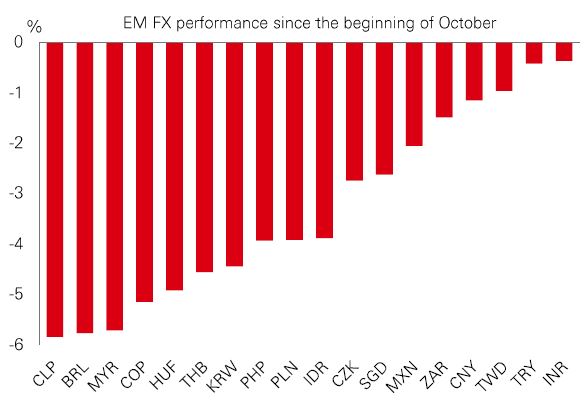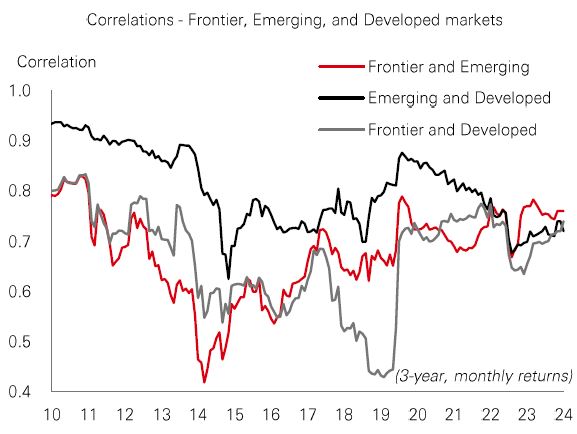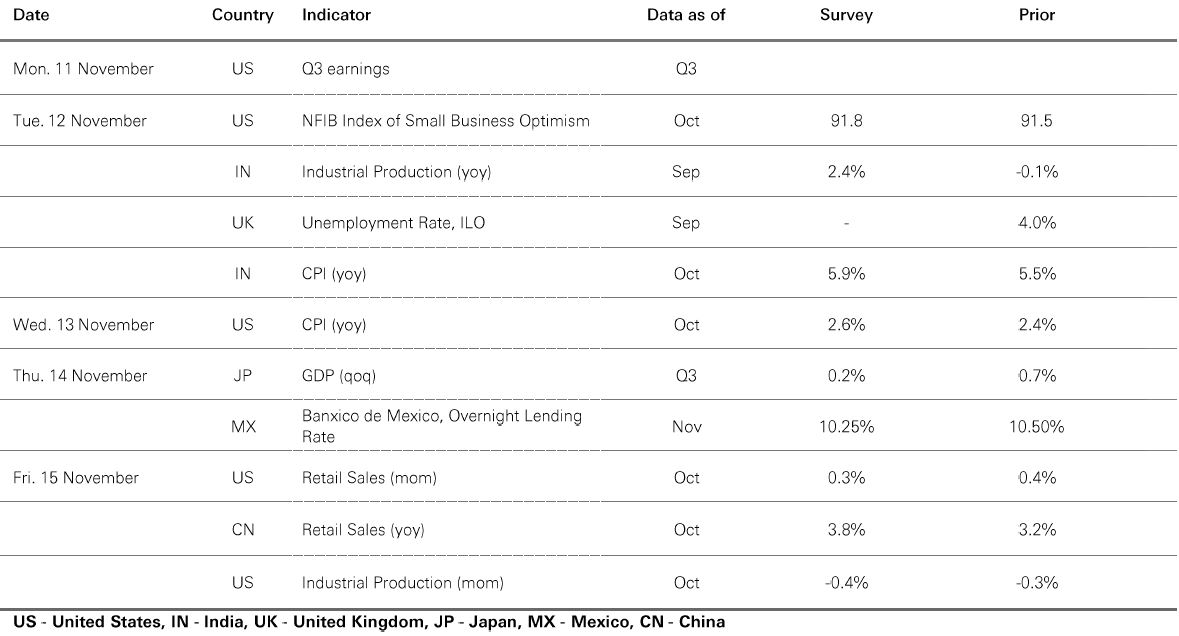
11 November 2024

The S&P 500 hit fresh all-time highs last week with the decisive outcome of the US presidential election removing one form of uncertainty for investment markets. US stocks also found a fresh catalyst via the potential for lower corporate tax rates and deregulation, boosting the profits outlook.
The recent good run in US stocks has coincided with a period of rising US Treasury yields. Investors are grappling with a likely combination of ongoing fiscal activism, global economic fragmentation, renewed inflationary pressures, and a shallower Fed rate cutting cycle.
So far, the stock market has shrugged off the pick-up in yields. But there is no guarantee that higher-for-longer rates won’t damage risk appetite. Investment markets have been “hypersensitive” to economic news this year. The addition of policy uncertainty could intensify market volatility.
US stock valuations look stretched and profits expectations are elevated. Positive European and Asian growth in 2025 suggests there is still room for markets outside of the US to perform. But for emerging markets, the dollar outlook is key, as is the next set of policy support measures from China.
The Fed looked through the noise of the US elections and delivered a 0.25% cut, which it had been expected to do for several weeks. The rationale for the move was that the funds rate is at restrictive levels while inflation is moderating, and the labour market is back in better balance.
Looking forward, the Fed is faced with a more uncertain outlook, given potentially large changes in fiscal and trade policy. Medium-term upside inflation risks have likely increased while the growth outlook has become more ambiguous – depending on the ultimate mix of fiscal and trade policies, growth could exceed or disappoint current expectations.
Given the more unpredictable outlook, Chair Powell may want to recall the words of former ECB President Mario Draghi, “In a dark room you move with tiny steps”. In other words, the best course of action is likely to be gradually taking the policy rate back towards a more neutral level unless data and events push you strongly to do something else.
The value of investments and any income from them can go down as well as up and investors may not get back the amount originally invested. Past performance does not predict future returns. Investments in emerging markets are by their nature higher risk and potentially more volatile than those inherent in some established markets. The level of yield is not guaranteed and may rise or fall in the future. For informational purposes only and should not be construed as a recommendation to invest in the specific country, product, strategy, sector or security. Any views expressed were held at the time of preparation and are subject to change without notice. Any forecast, projection or target where provided is indicative only and not guaranteed in any way. Diversification does not ensure a profit or protect against loss.
Source: HSBC Asset Management. Macrobond, Bloomberg. Data as at 7.30am UK time 08 November 2024.
Chinese stocks rallied in September on news of further policy support, and they’ve largely held those gains. Momentum picked up in early November, and the Shanghai Composite is still up 20%+ since the new measures were announced. Last week, the China National People’s Congress (NPC) Standing Committee approved an incremental increase of RMB6 trillion in the local government special debt limit to swap hidden debt over three years through the end of 2026.
For stocks, the prospect of further policy support could mean strong potential for growth and recovery. Some specialists see Chinese stocks continuing to trade at a wide discount to peers and still lightly-owned by international investors. They favour both quality growth companies and high dividend-paying stocks. That said, Chinese firms remain vulnerable to potential risks, including geopolitical tensions and any weakness in global economic conditions.

President-elect Trump’s victory in the US election, together with a strengthening dollar, has reinforced negative sentiment towards emerging market (EM) currencies and local-currency assets. Investors have been nervous about the potential impact of higher US tariffs on global trade, as well as potentially higher bond issuance and a widening of the US fiscal deficit. A repricing of US rate expectations hasn’t helped EM assets either.
Weaker EM currencies risk stoking inflation and could prompt a re-assessment of the EM policy outlook. Brazil’s central bank hiked rates by 0.50% in October to quell rising inflation, providing relief for the currency. The Brazilian real has weakened nearly 14% this year – hitting a record low following the US election – maintaining the pressure for further tightening amid rising concerns about the sustainability of fiscal policy. While this is a near-term risk for many EM economies, a number of currencies have long-term valuation buffers. The Fed-driven global easing cycle, albeit possibly slower and shallower, should limit downside risks, as should the policy-stimulus driven cyclical recovery in China.

A concern for investors ahead of the US election was the potential impact on global trade from aggressive US tariffs. One area which could prove resilient to greater trade frictions is frontier markets, where countries have learnt to steer a path between competing third parties.
Key to this is that frontiers are a relatively low correlation, low volatility asset class in the equity space, with domestically-driven economies. That can shelter them from global macro events. The shift towards a more multi-polar world has tested this, but frontiers are tending to prioritise neutrality.
In Gulf Cooperation Countries, for example, Saudi Arabia has opted to play a mediator role in regional tensions, preferring instead to focus on its domestic economy, social reforms, and diversifying from oil into sectors like tourism and leisure. Another example is Vietnam, which has managed to benefit from ’nearshoring’ but still maintains a positive trade partnership with both China and the US. All in, frontier markets could offer a route through potential tariff tensions.

Past performance does not predict future returns. The level of yield is not guaranteed and may rise or fall in the future. For informational purposes only and should not be construed as a recommendation to invest in the specific country, product, strategy, sector or security. Any views expressed were held at the time of preparation and are subject to change without notice.
Source: HSBC Asset Management. Macrobond, Bloomberg, Datastream. Data as at 7.30am UK time 08 November 2024.


Source: HSBC Asset Management. Data as at 7.30am UK time 08 November 2024. For informational purposes only and should not be construed as a recommendation to invest in the specific country, product, strategy, sector or security. Any views expressed were held at the time of preparation and are subject to change without notice.
Risk appetite rose following the presidential election in the US, with the US dollar strengthening on expectations of continued “US exceptionalism” and looser fiscal policy. Core government bonds weakened, with rising US fiscal concerns lifting US Treasury yields, led by the 10yr. The Fed lowered rates by 0.25%, hinting at a more cautious view on inflation, and the BoE lowered rates by 0.25%. In the US, equities saw broad-based gains, with the S&P500 reaching an all-time high. European stocks weakened, led by lower autos. The Nikkei 225 advanced, as the Japanese yen hovered around its 3-month low. In EM, mainland China’s Shanghai composite rallied on encouraging business surveys amid optimism over further fiscal stimulus. Hong Kong’s Hang Seng index and Korea’s Kospi moved higher. In commodities, OPEC+’s decision to delay production cuts supported oil prices. Gold fell, while copper edged higher.




This document has been issued by The Hongkong and Shanghai Banking Corporation Limited (the "Bank") in the conduct of its regulated business in Hong Kong and may be distributed in other jurisdictions where its distribution is lawful. It is not intended for anyone other than the recipient. The contents of this document may not be reproduced or further distributed to any person or entity, whether in whole or in part, for any purpose. This document must not be distributed to the United States, Canada or Australia or to any other jurisdiction where its distribution is unlawful. All non-authorised reproduction or use of this document will be the responsibility of the user and may lead to legal proceedings.
This document has no contractual value and is not and should not be construed as an offer or the solicitation of an offer or a recommendation for the purchase or sale of any investment or subscribe for, or to participate in, any services. The Bank is not recommending or soliciting any action based on it.
The information stated and/or opinion(s) expressed in this document are provided by HSBC Global Asset Management Limited. We do not undertake any obligation to issue any further publications to you or update the contents of this document and such contents are subject to changes at any time without notice. They are expressed solely as general market information and/or commentary for general information purposes only and do not constitute investment advice or recommendation to buy or sell investments or guarantee of returns. The Bank has not been involved in the preparation of such information and opinion. The Bank makes no guarantee, representation or warranty and accepts no responsibility for the accuracy and/or completeness of the information and/or opinions contained in this document, including any third party information obtained from sources it believes to be reliable but which has not been independently verified. In no event will the Bank or HSBC Group be liable for any damages, losses or liabilities including without limitation, direct or indirect, special, incidental, consequential damages, losses or liabilities, in connection with your use of this document or your reliance on or use or inability to use the information contained in this document.
In case you have individual portfolios managed by HSBC Global Asset Management Limited, the views expressed in this document may not necessarily indicate current portfolios' composition. Individual portfolios managed by HSBC Global Asset Management Limited primarily reflect individual clients' objectives, risk preferences, time horizon, and market liquidity.
The information contained within this document has not been reviewed in the light of your personal circumstances. Please note that this information is neither intended to aid in decision making for legal, financial or other consulting questions, nor should it be the basis of any investment or other decisions. You should carefully consider whether any investment views and investment products are appropriate in view of your investment experience, objectives, financial resources and relevant circumstances. The investment decision is yours but you should not invest in any product unless the intermediary who sells it to you has explained to you that the product is suitable for you having regard to your financial situation, investment experience and investment objectives. The relevant product offering documents should be read for further details.
Some of the statements contained in this document may be considered forward-looking statements which provide current expectations or forecasts of future events. Such forward looking statements are not guarantees of future performance or events and involve risks and uncertainties. Such statements do not represent any one investment and are used for illustration purpose only. Customers are reminded that there can be no assurance that economic conditions described herein will remain in the future. Actual results may differ materially from those described in such forward-looking statements as a result of various factors. We can give no assurance that those expectations reflected in those forward-looking statements will prove to have been correct or come to fruition, and you are cautioned not to place undue reliance on such statements. We do not undertake any obligation to update the forward-looking statements contained herein, whether as a result of new information, future events or otherwise, or to update the reasons why actual results could differ from those projected in the forward-looking statements.
Investment involves risk. It is important to note that the capital value of investments and the income from them may go down as well as up and may become valueless and investors may not get back the amount originally invested. Past performance contained in this document is not a reliable indicator of future performance whilst any forecasts, projections and simulations contained herein should not be relied upon as an indication of future results. Past performance information may be out of date. For up-to-date information, please contact your Relationship Manager.
Investment in any market may be extremely volatile and subject to sudden fluctuations of varying magnitude due to a wide range of direct and indirect influences. Such characteristics can lead to considerable losses being incurred by those exposed to such markets. If an investment is withdrawn or terminated early, it may not return the full amount invested. In addition to the normal risks associated with investing, international investments may involve risk of capital loss from unfavourable fluctuations in currency values, from differences in generally accepted accounting principles or from economic or political instability in certain jurisdictions. Narrowly focused investments and smaller companies typically exhibit higher volatility. There is no guarantee of positive trading performance. Investments in emerging markets are by their nature higher risk and potentially more volatile than those inherent in some established markets. Economies in emerging markets generally are heavily dependent upon international trade and, accordingly, have been and may continue to be affected adversely by trade barriers, exchange controls, managed adjustments in relative currency values and other protectionist measures imposed or negotiated by the countries with which they trade. These economies also have been and may continue to be affected adversely by economic conditions in the countries in which they trade. Mutual fund investments are subject to market risks. You should read all scheme related documents carefully.
Copyright © The Hongkong and Shanghai Banking Corporation Limited 2024. All rights reserved. No part of this publication may be reproduced, stored in a retrieval system, or transmitted, on any form or by any means, electronic, mechanical, photocopying, recording, or otherwise, without the prior written permission of The Hongkong and Shanghai Banking Corporation Limited.
Issued by The Hongkong and Shanghai Banking Corporation Limited